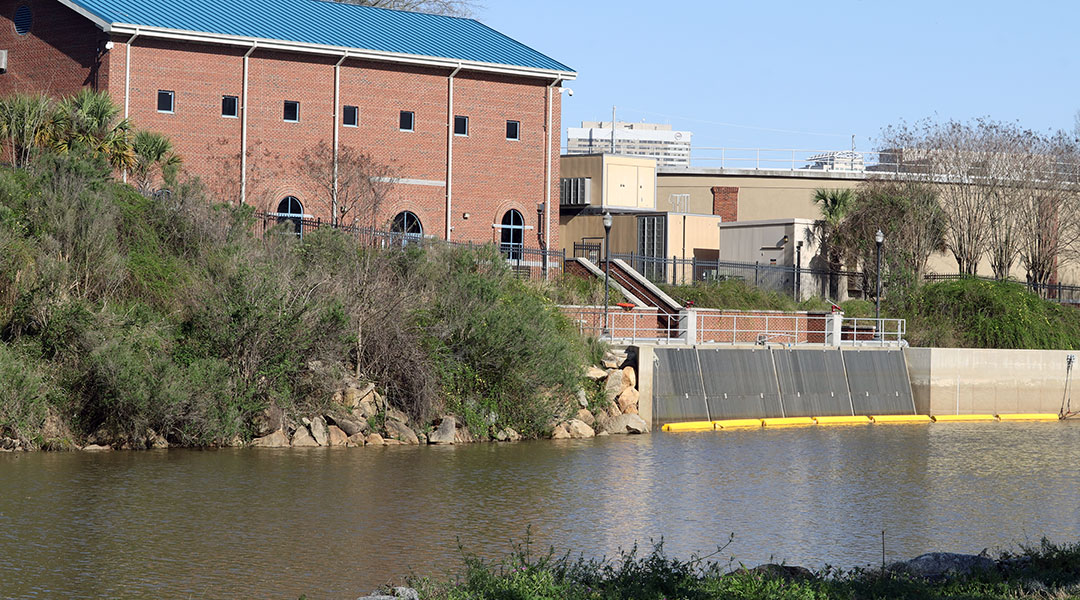The Columbia Canal Water Treatment Plant overseas the distribution of drinking water and water quality for residents from large portions of Richland and Lexington counties. (Photos by Jacob Phillips)
The Environmental Protection Agency will announce as early as this month a new proposed maximum contaminant level for two “forever chemicals” found in South Carolina’s water.
State health officials have been monitoring drinking water since June 2020 for per- and polyfluoroalkyl substances, or PFAS. And cities have known there’s a problem.
Now, the EPA is expected to set the a fixed maximum allowable level for two kinds of the toxic PFAS, perfluorooctane sulfonic acid (PFOS) and perfluorooctanoic acid (PFOA).
“This is probably one of the most complex and challenging issues that we’ve been currently spending a lot of our time and resources (on),” said Myra Reece, the environmental affairs director for S.C. Department of Health and Environmental Control.
DHEC tested for PFAS in 34 water bodies from July to December 2022.
At least one of the toxic chemicals was found in each source, with all but three sources testing positive for both substances.
Reece said most people come in contact with PFAS every day and don’t know it.
The EPA estimates that 20% of a person’s exposure to PFAS comes from drinking water.
The assumed lifetime consumption is 2.5 liters of contaminated water per day for 70 years.
“PFAS are in water, but they don’t start out in water,” said Fran Marshall, DHEC’s director of applied science and community engagement. “They’ve been in use in manufacturing and then consumer products since the 1940s. So we have a lot of them in our environment, and they don’t break down.”
The chemicals are man-made and are used in products because of their resistance to water and grease.
They can be found in items such as food packaging, microwaved popcorn, cosmetics, treated fabrics and carpets, non-stick cookware, dental floss and other everyday items.
Overexposure to PFAS can change liver enzymes and increase cholesterol levels. It also can heighten the risk of kidney or testicular cancer and the risk of high blood pressure in pregnant women.
DHEC has known about the potential toxins in drinking water for years.
It ran an initial round of PFAS testing from 2013 to 2015.
The department gathered 493 samples, and only one tested positive for PFAS. But those tests were misleading.
“We felt good about that,” said Doug Kinard, the Bureau of Water Division Director for DHEC. “But we began hearing … laboratory detection limits were not low enough, and that new lab methods had lower detection limits, and that if we were not finding PFAS in our state, then we were not looking low enough.”
That’s what started the 2020 testing. Kinard said DHEC expects to finish data collection later this year while the EPA starts its own monitoring that will last until 2025.
“Once the EPA’s proposed (new limits are) released, we will already have a very good understanding of the impact it will have on public water systems in the state,” Kinard said.
Water treatment centers will have three years to comply with the EPA’s limits once they’re finalized.
In the meantime, there are a number of things consumers can do to limit their exposure to PFAS.
One way is by replacing scratched non-stick cookware with stainless steel or cast iron, said Sandra Snyder, DHEC’s unregulated compounds specialist.
“Also go back to popping your popcorn on the stove,” Snyder said. “Everything that you can cut back on that has PFAS, you’re reducing your risk, even if it’s just a small thing.”
There are also water filters that will remove PFAS from the water if the instructions are followed correctly.
Municipal treatment centers in South Carolina won’t wait for the new limits to start planning how to treat contaminated water, Kinard said.
“We have interactions with a lot of different professional organizations where everyone is discussing what we will do once (those new limits) set,” Kinard said. “They’re probably already making capital improvement plans for what they’ll have to do to meet that.”
Marshall said the public should try to stay informed and not panic.
“We all want people to understand the risk in the environment,” Marshall said. “We don’t want them to be overly concerned, and we don’t want them to be under concerned. We want them to be just the right amount of concerned. And we feel like educating folks is the best way for them to understand these things.”




